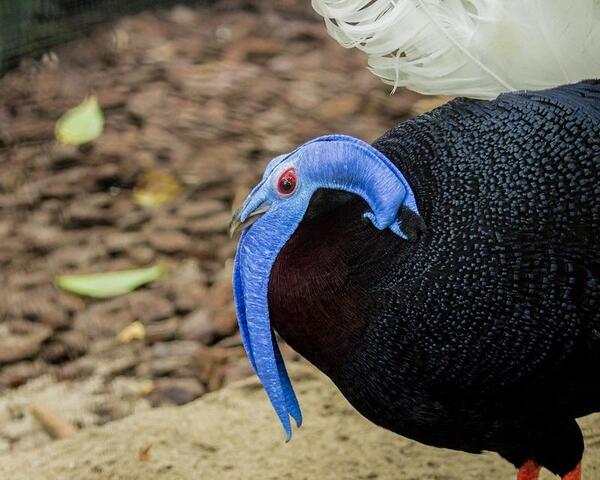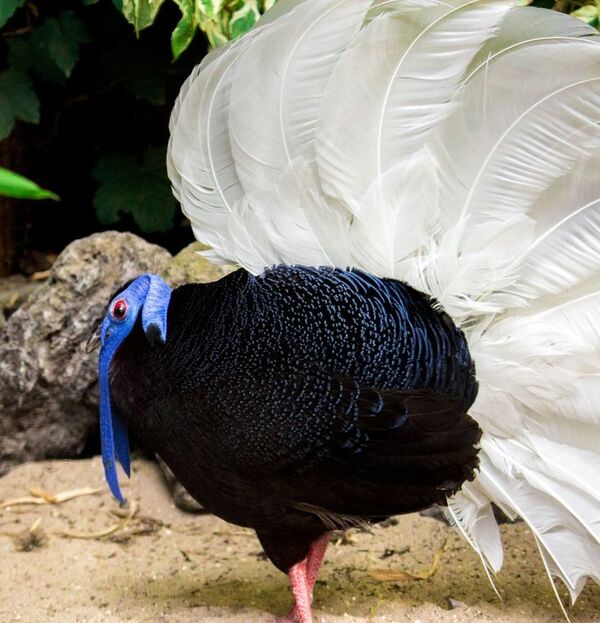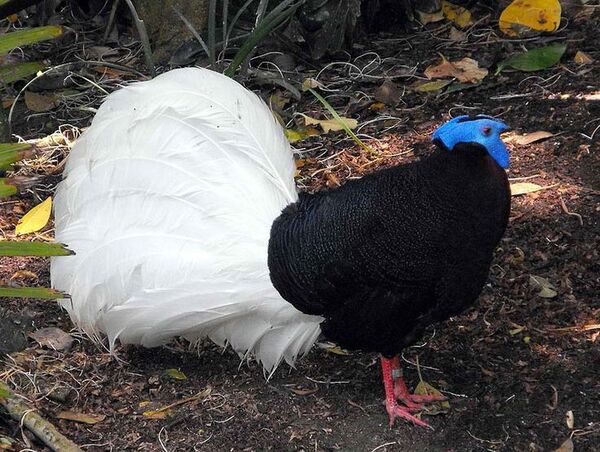Bulwer's pheasant (Lophura bulweri) also known as Bulwer's wattled pheasant, the wattled pheasant or the white-tailed wattled pheasant,is a species of pheasant endemic to Southeast Asia, specifically found in the mountainous forests of Borneo and Sumatra. Known for its strikingly beautiful plumage and unique behaviors, it is a bird that has captured the interest of both ornithologists and bird enthusiasts around the world. This article delves into the scientific classification, physical features, habitat, and behavior of the Bulwer's pheasant, providing a comprehensive understanding of this captivating species.
Understanding the Bulwer's pheasant starts with its scientific classification. The bird belongs to the following hierarchical categories:
Kingdom: Animalia
Phylum: Chordata
Class: Aves
Order: Galliformes
Family: Phasianidae
Genus: Lophura
Species: Lophura bulweri
This classification places the Bulwer's pheasant within the Phasianidae family, which also includes other well-known pheasants, like the Indian peafowl and the red junglefowl. However, the Bulwer's pheasant is distinct due to its unique markings and elegant appearance.

One of the most notable features of the Bulwer's pheasant is its plumage. The male is particularly striking, with a vibrant blue body adorned with long, iridescent feathers that shimmer in the sunlight. The head is adorned with a blue-black crest that adds to its grandeur. The tail feathers are long and elegant, extending well beyond the body, which helps distinguish the male from the female.
The female Bulwer’s pheasant, while still attractive, has a more muted color palette, primarily brown and tan, which helps her camouflage in the forest floor’s leaf litter. Both sexes share a distinctive white patch around their neck, which contrasts sharply with the rest of their plumage.
The Bulwer's pheasant is a medium-sized bird, with notable sexual dimorphism, meaning the males and females differ in size and appearance.
Male Bulwer's Pheasant: Males are larger than females, with an average body length of 85-95 cm (33-37 inches). Their long tail feathers, which can measure up to 60 cm (24 inches) in length, contribute to the impressive overall length. The long, iridescent plumage on their body adds to their size, making them appear even more majestic.
Female Bulwer's Pheasant: Females are smaller, typically measuring 60-70 cm (24-28 inches) in body length. They have shorter tails compared to the males, usually around 25 cm (10 inches) long. The female's overall appearance is more muted, with brown and gray tones, allowing her to blend better with the forest floor.
Male: Males of the species generally weigh between 1.5 to 2 kg (3.3 to 4.4 pounds). Their weight is distributed across their large body and long tail feathers, which help with balance during movement and courtship displays.
Female: Females are slightly lighter, weighing between 1 to 1.5 kg (2.2 to 3.3 pounds). The weight difference between males and females is common in many pheasant species, as males tend to be larger and more flamboyant to attract mates.

The Bulwer's pheasant is native to the tropical rainforests of Borneo and Sumatra. These lush, humid forests provide the ideal environment for the species to thrive, with a dense canopy of trees that offers both food and shelter. The bird is typically found at altitudes between 1,200 to 2,500 meters in montane regions, where the climate is cool and the forest is rich with biodiversity.
Unfortunately, due to deforestation and habitat degradation in parts of Southeast Asia, the Bulwer's pheasant's habitat is becoming increasingly fragmented. This poses a serious threat to their population numbers, making the species vulnerable.
The Bulwer's pheasant is generally a solitary bird, although it does come together during the breeding season. It is often seen foraging alone in the underbrush of the forest. The bird has an interesting foraging behavior, often walking along the forest floor and scratching through the leaf litter in search of seeds, berries, and small invertebrates.
In terms of social structure, Bulwer's pheasants tend to be rather reclusive. They don’t form large flocks like other species of pheasants. Instead, their interactions are typically limited to the mating season when males perform elaborate courtship displays to attract females.
The Bulwer's pheasant follows a seasonal reproductive cycle, typically breeding during the monsoon season when food is plentiful. The male plays a crucial role in attracting a mate, performing an elaborate courtship display that includes puffing out his chest, spreading his tail feathers, and calling to attract a female. These displays are designed to show off his physical fitness and help him stand out from other males.
Courtship Display: The male’s display is quite a spectacle. He will raise his crest and extend his tail, creating an impressive fan. His calls are varied, including soft clucks and more melodious sounds, which serve to draw attention to his colorful plumage and fitness.
Once a female chooses a mate, she will lay her eggs in a well-hidden nest on the forest floor. The nest is often built in dense underbrush, helping to protect the eggs from predators. A typical clutch consists of 2 to 3 eggs. The eggs are oval-shaped and have a light brown or grayish coloration with darker speckles.
Incubation: The female alone incubates the eggs, which takes around 26 to 28 days. During this time, she remains on the nest for most of the day, only leaving to forage for food. The male’s role during the incubation period is minimal, as he continues to patrol the area and protect the territory.
Once the eggs hatch, the chicks are precocial, meaning they are born with their eyes open and are capable of walking and foraging soon after birth. However, the mother still provides protection and guidance, especially in the early stages of life. The chicks are fed a diet of small insects, seeds, and leaves, which they forage for under the careful supervision of the mother. As they grow, they become more independent and learn the ways of the forest.
The lifespan of the Bulwer’s pheasant in the wild can vary depending on environmental factors, predators, and availability of resources. On average, these birds live for about 5 to 7 years in the wild. However, their lifespan can be significantly impacted by human activity, such as habitat destruction and hunting.
In the Wild: In the wild, the Bulwer’s pheasant faces various threats, including predation by larger carnivores and birds of prey, such as eagles and hawks. In addition, the loss of habitat can increase mortality rates. However, with their ability to hide in dense forests and their elusive nature, they can avoid some threats, allowing them to live longer lives in relatively undisturbed habitats.
In Captivity: When kept in zoos or wildlife reserves, the Bulwer’s pheasant tends to live longer due to the controlled environment, absence of predators, and consistent food supply. In captivity, they may live for 10 to 12 years or more, depending on their health and the quality of care they receive.
Size: Males are larger than females, with a body length of 85-95 cm (males) vs. 60-70 cm (females).
Weight: Males weigh between 1.5-2 kg, while females weigh between 1-1.5 kg.
Reproduction: Mating involves elaborate courtship displays by the males; females lay 2-3 eggs, which are incubated for 26-28 days.
Lifespan: In the wild, the Bulwer’s pheasant lives for 5-7 years, while in captivity, it can live 10-12 years.

The Bulwer’s pheasant is an omnivore, and its diet primarily consists of seeds, fruits, leaves, and small invertebrates. Insects like ants, beetles, and termites are a significant part of their diet, providing them with much-needed protein. These pheasants are ground feeders, often seen scratching through the leaf litter in search of food. They also feed on the fallen fruits of various forest trees, making them an integral part of the forest’s ecosystem.
Interestingly, the Bulwer’s pheasant is not particularly picky about its food and will consume almost anything that is available in its environment. This adaptability to its food sources has helped it survive in the diverse and sometimes unpredictable conditions of Southeast Asia’s rainforests.
The Bulwer’s pheasant is listed as Near Threatened by the International Union for Conservation of Nature (IUCN). Habitat loss due to deforestation is the primary threat to the species. As forests are cleared for agriculture and urbanization, the Bulwer’s pheasant finds its natural habitat shrinking and becoming more fragmented.
In addition to habitat destruction, the Bulwer’s pheasant is also threatened by hunting and trapping, though it is not typically targeted as heavily as some other species in the region. Despite this, local hunting practices, particularly in remote areas, still pose a risk to the bird’s population.
Several conservation initiatives are underway to protect the Bulwer’s pheasant. These efforts focus on habitat restoration and the creation of protected areas where the bird can thrive. There is also a push to raise awareness about the bird’s plight among local communities to reduce hunting pressures.
Furthermore, zoos and wildlife reserves are working on breeding programs to help bolster the Bulwer’s pheasant population and maintain genetic diversity within the species. Conservationists are hopeful that with increased protection, this stunning bird can be preserved for future generations.
The Bulwer’s pheasant is notoriously elusive and not easy to spot in the wild. Its preference for dense forests and its quiet, solitary nature make it difficult to observe in its natural habitat.
While both male and female Bulwer’s pheasants are beautiful, the males are particularly striking with their shimmering blue feathers and long, flowing tail. Their plumage is a true marvel of nature.
Because of its elusive behavior and remote habitat, the Bulwer’s pheasant is a bird that only a lucky few birdwatchers ever get the chance to see in person. Even those who live in the regions it inhabits might never spot one due to its solitary and secretive nature.
The Bulwer’s pheasant is undoubtedly one of the most visually stunning and ecologically significant birds in Southeast Asia. With its striking plumage, fascinating behavior, and important role in the ecosystem, it represents both the beauty and fragility of the world’s tropical rainforests. However, with increasing threats from habitat loss and human encroachment, it is vital that conservation efforts continue to protect this species.
Through continued research, habitat preservation, and global conservation initiatives, there is hope for the future of the Bulwer’s pheasant. This bird, with its elegance and mystique, deserves a place in our efforts to safeguard biodiversity and maintain the health of the world’s forests.
animal tags: Bulwer-s-pheasant
We created this article in conjunction with AI technology, then made sure it was fact-checked and edited by a Animals Top editor.